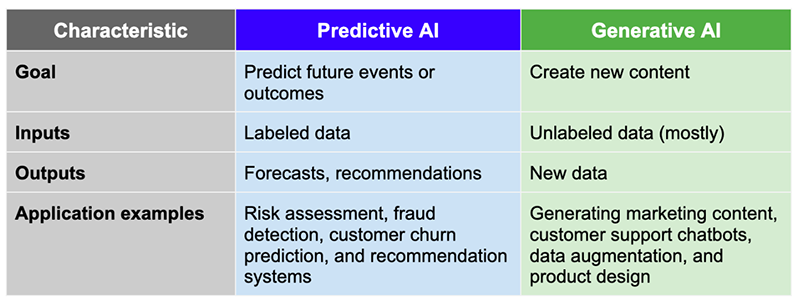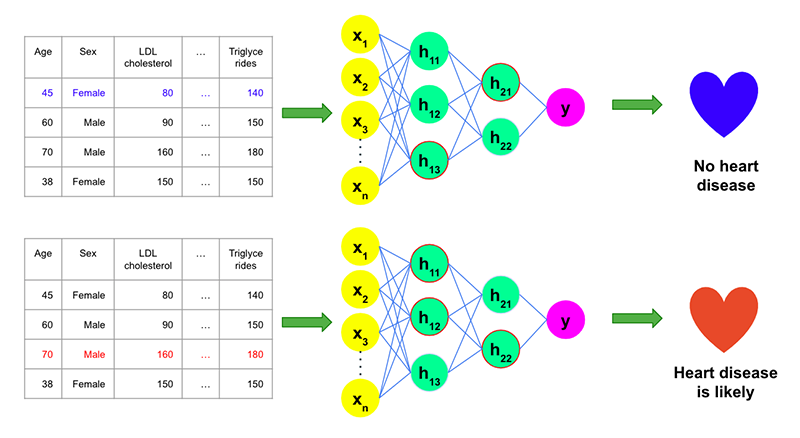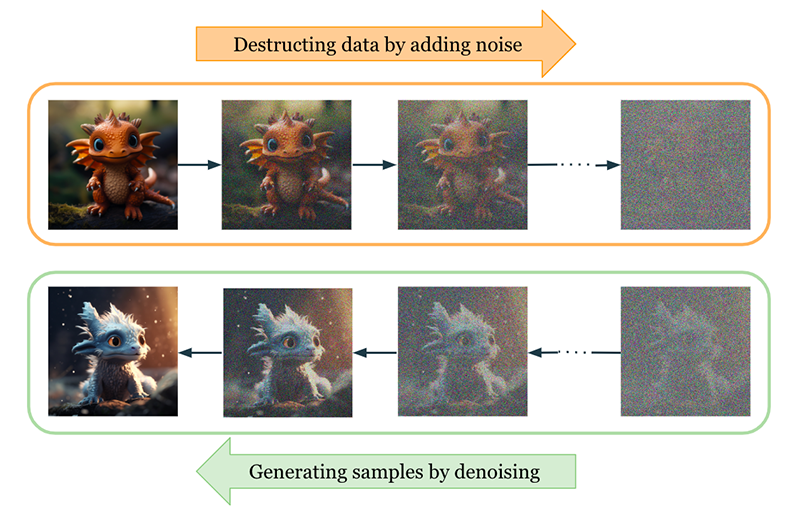
Generated with Bing and edited with Photoshop
Predictive AI has been driving companies’ ROI for decades through advanced recommendation algorithms, risk assessment models, and fraud detection tools. However, the recent surge in generative AI has made it the new hot topic. Everyone is looking into leveraging large language models for content generation and customer service or diffusion models for visual content creation. Is generative AI about to become the key driver for increased productivity?
To answer this question, we need to look deeper into the topic to understand the key application areas of generative and predictive AI. In this article, we will review the key machine-learning techniques driving these two major classes of AI approaches, the unique benefits and challenges associated with them, and their respective real-world business applications.
Basic Definitions
Generative AI and predictive AI are two powerful types of artificial intelligence with a wide range of applications in business and beyond. Both types of AI use machine learning to learn from data, but they do so in different ways and have different goals.
Predictive AI is used to predict future events or outcomes based on historical data. It does this by identifying patterns in historical data and then using those patterns to forecast future trends. For example, a predictive AI model can be trained on a dataset of customer purchase history data and then used to predict which customers are most likely to churn in the next month.
Generative AI is a type of AI that can create new content, such as text, images, music, and code. It does this by learning from existing data and then generating new data that is similar to the training data. For example, a generative AI model can be trained on a dataset of ad copy examples and then used to generate new creative and effective ad copies.

The basic difference is that predictive AI outputs predictions and forecasts, while generative AI outputs new content. Here are a few examples across various domains:
- Natural Language Processing (NLP): Predictive NLP models can categorize text into predefined classes (e.g., spam vs. not spam), while generative NLP models can create new text based on a given prompt (e.g., a social media post or product description).
- Image processing: Predictive image processing models, such as convolutional neural networks (CNNs), can classify images into predefined labels (e.g., identify different products on a grocery store shelf). On the other hand, generative models like diffusion models can create new images that are not present in the training data (e.g., virtual models for advertising campaigns).
- Drug discovery: Predictive drug discovery models can forecast whether a new compound is likely to be toxic or have potential as a new drug treatment. Generative drug discovery models can create new molecular structures with desired properties, such as higher efficacy or lower toxicity.
The different machine learning algorithms driving these two types of AI have specific strengths and weaknesses that you need to understand to choose the right approach for your business needs.
If this in-depth educational content is useful for you, subscribe to our AI mailing list to be alerted when we release new material.
How Do Predictive vs. Generative AI Algorithms Work
Predictive AI is a type of AI that uses historical data to make predictions about future events or outcomes. It is usually based on supervised learning, which is a type of machine learning that requires labeled data. Labeled data is data that has been annotated with correct input and output pairs or series. The model learns the mathematical relationship between the input data and the output data, and then uses this knowledge to make predictions about new data.
The predictive AI algorithms can be used to predict a wide range of variables, including continuous variables (e.g., sales volume) and binary variables (e.g., whether a customer will churn). They can be based on basic machine learning models like linear regression, logistic regression, decision trees, and random forests. In some cases, deep learning algorithms and reinforcement learning demonstrate exceptional performance for predictive AI tasks thanks to their ability to learn complex patterns in data. This makes these algorithms well-suited for tasks such as predicting customer behavior, detecting frauds, or forecasting patient outcomes.

Let’s say a healthcare provider wants to use predictive AI to identify patients at risk of heart disease. They may use historical data from their previous patients to see how different features, such as patients’ demographic data, health conditions, and treatments, were associated with heart disease. Machine learning models can spot unexpected patterns and provide quite accurate predictions about which patients are more likely to develop heart disease. Healthcare providers can then use these predictions to develop personalized prevention plans.
In contrast to predictive AI, generative AI models are typically trained using unsupervised or semi-supervised learning algorithms. This means that they do not require large amounts of labeled data. Unsupervised learning algorithms learn from unlabeled data, while semi-supervised learning algorithms learn from a combination of unlabeled data and a small amount of labeled data.
Basically, most of the current generative AI models are built by masking part of the training data and then training the model to recover the masked data.
For example, large language models (LLMs) are trained by randomly replacing some of the tokens in training data with a special token, such as [MASK]. The model then learns to predict the masked tokens based on the context of the surrounding words.
Another common type of generative AI model are diffusion models for image and video generation and editing. These models are built by first adding noise to the image and then training the neural network to remove noise.

Both LLMs and diffusion models can achieve outstanding performance when trained on sufficiently large amounts of unlabeled data. However, to improve results for specific use cases, developers often fine-tune generative models on small amounts of labeled data. Integrating human feedback through reinforcement learning can further improve a model’s performance by reducing a number of adversarial responses.
Marketing is one of the first business areas to benefit from generative AI. For example, a marketing agency might use a generative AI model to generate creative content, such as blog posts, articles, and social media posts. First, they can select a pretrained LLM that demonstrates acceptable performance for their use case. Then, they can fine-tune the model on a dataset of existing content from the agency’s clients. Once trained, the model could be used to generate new content that is tailored to the agency’s clients’ needs.
Strengths and Weaknesses
When it comes to predictive AI, here are the key benefits of using this technology:
- High accuracy: Predictive AI models can be trained to achieve very high accuracy for many tasks, such as product recommendation, fraud detection, and risk assessment.
- Automation: Predictive AI can automate many tasks and free up human workers to focus on more strategic and creative work.
However, this type of AI comes with its challenges, such as for example:
- Labeled data requirement: Predictive AI models require labeled data, which can be expensive and time-consuming to collect.
- High bar for success: Predictive AI applications need to be highly accurate to be successful. This can be difficult to achieve, especially for complex tasks.
- Model maintenance: Predictive AI models need to be regularly retrained on new data in order to maintain their accuracy. This can be a challenge for companies with limited resources.
Generative AI algorithms have their own strengths points:
- Increased productivity and efficiency: Generative AI can make the process of content creation, code writing, image creation, and designing much faster. This can save businesses a significant amount of time and money.
- Creativity: Generative AI can generate new and innovative ideas that humans may not have thought of. This can help businesses to develop new products and services, and to improve their existing products and services.
However, as a very new technology, it has a number of challenges to take into account, including:
- Lack of reliability: Generative AI applications tend to be highly unreliable. They may produce false or misleading information, and will usually require a human in the loop for any customer-facing applications.
- Reliance on pretrained models: Businesses typically need to rely on externally created pretrained models for generative AI applications. This can limit their control over the model and its output.
- Copyright and intellectual property issues: There are copyright and intellectual property concerns surrounding the use of generative AI models. For example, it is unclear who owns the copyright to the content generated by a generative AI model that was trained on copyrighted data.
These strengths and weaknesses largely determine the key application areas for generative AI and predictive AI. Let’s take a closer look.
Real-World Applications
The application areas of predictive AI are defined by its ability to produce highly accurate forecasts that allow certain tasks to be fully automated. At the same time, these are also the areas where it is possible to obtain enough labeled data to train the AI model. Some examples of predictive AI applications include:
- Product recommendation systems: Predictive AI can be used to recommend products to customers based on their past purchase history and browsing behavior.
- Fraud detection systems: Predictive AI can help identify fraudulent transactions and activities.
- Risk assessment systems: Predictive AI models allow businesses to assess the risk of events such as loan defaults, insurance claims, and customer churn.
- Demand forecasting systems: By accurately forecasting demand for products and services, predictive AI helps businesses plan their production and inventory levels, and develop marketing campaigns.
- Predictive maintenance systems: AI can be used to predict when machines and equipment are likely to fail, thus helping companies prevent costly downtime and extend the life of their assets.
Unlike predictive AI, generative AI does not require us to produce the most optimal output. Automatically generated results that are “good enough” can still help businesses increase productivity and efficiency, making generative AI solutions worth implementing. However, it is important to remember that generative AI applications are not reliable and may produce false information or unexpected outputs when deploying them.
Considering these limitations, generative AI is best suited for experimental settings where correctness is not essential (such as for example, AI persona chatbots) or for applications with a human in the loop, where humans review and edit all model outputs before publishing, sending, or executing them.
Some examples of generative AI applications include:
- Content creation: Generative AI models can accelerate the generation of blog posts, product descriptions, and social media ads. For example, writers can provide detailed instructions to guide the generation of content, and then review and edit the output.
- Image generation: Generative AI can be used to generate realistic images and videos in product design, marketing, and entertainment. Designers can then review, edit, and arrange this automatically generated visual content instead of creating it from scratch.
- Code generation: Generative AI models can be used to write code for software applications or suggest code changes to developers. Developers can then review and edit the code before executing it.
- Drug discovery: Generative AI can accelerate drug development by identifying new drug candidates and predicting their properties, while humans ensure quality control and assess drug models generated by AI.
Predictive AI is still dominating the high-value AI market, as it can automate processes with high accuracy, eliminating the need for human oversight. Generative AI, on the other hand, is a newer and rapidly developing field with the potential to revolutionize many business applications. While it remains to be seen whether generative AI will become a major productivity driver comparable to predictive AI, its potential is undeniable.
Enjoy this article? Sign up for more AI research updates.
We’ll let you know when we release more summary articles like this one.
Related
- SEO Powered Content & PR Distribution. Get Amplified Today.
- PlatoData.Network Vertical Generative Ai. Empower Yourself. Access Here.
- PlatoAiStream. Web3 Intelligence. Knowledge Amplified. Access Here.
- PlatoESG. Carbon, CleanTech, Energy, Environment, Solar, Waste Management. Access Here.
- PlatoHealth. Biotech and Clinical Trials Intelligence. Access Here.
- Source: https://www.topbots.com/generative-vs-predictive-ai/



